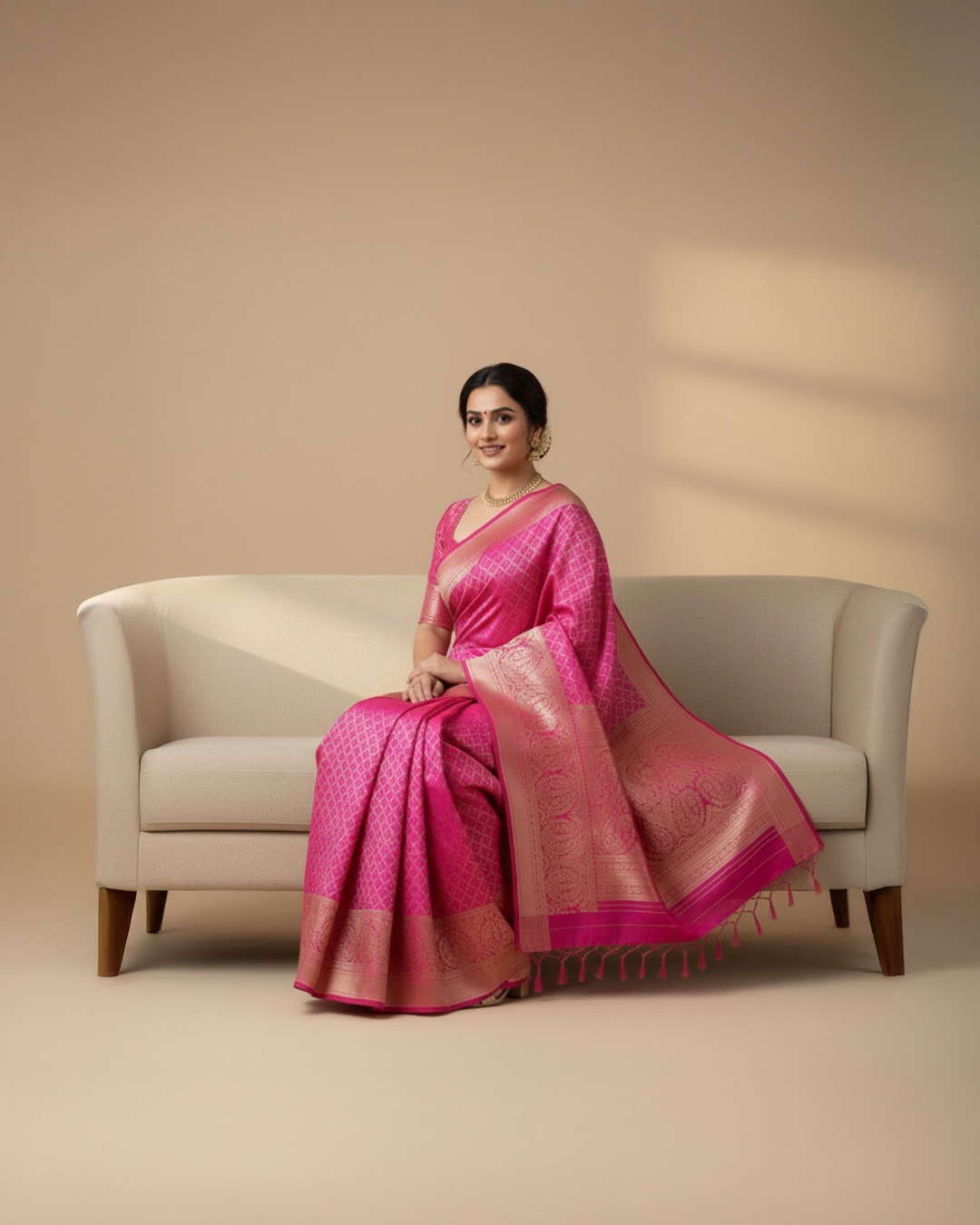When it comes to Indian ethnic wear, the Banarasi saree stands in a league of its own—full of tradition, craftsmanship and elegance. But how much should you really expect to pay for one? Let’s dive into the factors that influence the cost of a true Banarasi saree, typical price ranges, and even a real-life example you can check out.
1. Why prices vary so much
Several key elements drive the cost of a Banarasi saree:
Material & weave
- If it’s pure silk (think “Katan”, “Mulberry silk”), the cost goes up significantly. Blended fabrics (silk-blend, art-silk) are more affordable.
- How heavy the fabric is, how fine the threads, how complex the weave—all these matter.
Zari and motifs
- The gold or silver‐thread zari work (or even imitation zari) affects cost a lot. Pure metal zari is expensive.
- The intricacy of the motifs, the amount of brocade or supplementary weaving, the finishing—all these add cost.
Handloom vs power-loom & heritage
- A saree woven by master weavers, especially handloom in Varanasi, carries higher value.
- The heritage of the weave, brand reputation, provenance (GI-tag etc) also affect price.
Where you buy & brand
- Retail mark-ups, shipping, import duties (if any), branding can push up price.
- Discounts, online sales or lower-cost fabrics will reduce it—so be aware of what you’re getting.
2. Typical price ranges in India
Here are rough benchmarks (at time of writing) for what you’ll encounter:
- Budget / entry-level: Sarees with blended fabrics, synthetic zari, machine weaving or lighter work—these might start around ₹3,000 to ₹12,000.
- Mid-range authentic: Pure silk (or high‐grade silk blends) with good zari, handcrafted details, decent brand/support—prices may fall in ₹12,000 to ₹30,000.
- High end / designer / heirloom: Ultra-premium sarees with heavy gold zari, top silk, intricate weaving (Kadwa butta, Jamdani style etc) can run ₹30,000 to ₹1,00,000+ even several lakhs.
- Note: When you see a “Banarasi” listed at an extremely low price (say under ₹5,000), you should investigate whether it’s truly handloom, pure silk, or just a look-alike.
3. A real example from the market
Here’s one for illustration:
akdoo Woven Banarasi Silk Blend Saree
- The listing currently shows an offer price of just ₹799 (or around ₹716 after discount offers) for the silk-blend version.
- It’s labelled “Banarasi silk-blend” (not pure silk) and given the very low price, it likely is machine-woven or power-loom, with lighter zari work.
- What this tells us: Even though it says “Banarasi”, the price and fabric suggest it’s in the very budget category for Banarasi‐style sarees.
- If you’re fine with a lightweight, affordable version for casual or festive wear, this is a good deal. But if you’re seeking the authentic heavy silk + premium zari heirloom piece, you’ll need to plan a higher budget.
4. How to check authenticity and value
To ensure you pay wisely and get what you expect, here are some tips:
- Check the reverse side of the saree: In handloom Banarasi, you’ll often see some irregularity because of the weaving process.
- Check the weight and feel: Pure silk + real zari will feel heavier and richer than cheap synthetic or machine versions.
- Ask about the fabric composition, the zari (is it pure metal, alloy, or synthetic thread?)
- Inquire about weaving technique (Kadwa, Jaal, Butta, Jamdani) — certain techniques cost more.
- Check for brand, provenance, or if you’re buying from Varanasi, whether you’re dealing with a known weaver or heritage shop.
- Review the price: If the price is suspiciously low (say a “pure silk heavy zari” close to ₹5,000) but the seller claims premium specs, dig deeper.
- Compare with your budget and occasion: If you’re buying for everyday wear or a small function, a lower‐price blend might be fine. For a wedding or heirloom, opt for the real deal.
5. What your budget should look like
Here are some budget scenarios to help you decide:
- Casual festive wear / light usage: You might be comfortable with a silk‐blend or art‐silk Banarasi saree in the ₹5,000 to ₹12,000 range.
- Wedding or big occasion: Aim for pure silk, good zari work, reputable brand/handloom source; budget ₹15,000 to ₹30,000 or more.
- Heirloom / major investment: Expect to pay ₹30,000+ for something that will last generations and hold value.
6. Final thoughts
In short: A real Banarasi saree is more than just six yards of fabric—it’s a piece of art, heritage and craftsmanship. Because of that, when you see a “Banarasi” for very low price you must ask: Is it pure silk? Is the zari quality premium? Is it handloom or machine‐made?
Let’s revisit our real example: The akdoo silk-blend Banarasi saree linking here is fine for a budget-friendly option (₹799 or ₹716 offer) — and looks good for casual/festive wear — but it doesn’t bring you into the premium tier of true, authentic Banarasi craftsmanship.
When you buy with knowledge, you’ll get far more satisfaction—knowing you’ve invested in true value rather than just a label.
